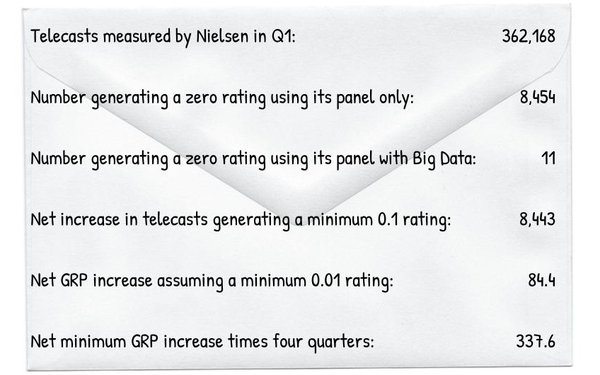Commentary
Because A Zero Is Hard To Sell
- by Joe Mandese @mp_joemandese, September 1, 2023

Apologies for taking so long to weigh in on the latest Nielsen brouhaha this week, but I've been scratching my head -- and asking smarter people than me some questions -- before I did.
You can read my interview with Media Rating Council chief George Ivie to understand what a smarter person has to say, but despite his good advice that calculating the impact of Nielsen's shift to its Big Data + panel ratings methodology, I did some back-of-the-envelope math anyway.
Given what Ivie says, you can take it with a grain of salt.
Using Nielsen Chief Data and Research Officer Pete Doe's blog post earlier this week as a basis, my crude math projects the Big Data shift will create a minimum of 337.6 rating points each year for telecasts that previously were unable to score a rating.
advertisement
advertisement
And while that may seem like a small adjustment relative to the 1.5 million telecasts Nielsen will measure this year -- many of which will reap much more than a 0.01 rating -- it's not nothing.
And most importantly, it is coming from somewhere, because those new GRPs are not incremental. They are are percentage of a universe of 123.8 million households (312.2 million people) that potentially could watch all those telecasts, and that is a fixed number.
It's also increasingly fragmented -- not just because their viewing is being divided across 1.5 million telecasts, but because more of them now spend more time watching TV-like content on platforms and devices that we don't even call "television."
So where are those 337.6 newly minted GRPs coming from? A lot of higher-rated and lower-rated TV shows that had previously been divvying up a somewhat smaller pie.
And that's where the math gets complicated, because as Ivie explains, it's not a linear progression, but a binary function: meaning that regardless of the methodology used by Nielsen -- panel-only, or Big Data + panel, or whatever it comes up with next -- a telecast either yields enough of the math to qualify for a minimum rating, or it does not. It's an either/or proposition.
But the bottom line is a lot more shows that were unable to make that proposition before, will be able to do so now, even if Nielsen is not releasing the Big Data powered ratings for "measurement purposes" only, and not for transacting advertising buys on.
Because the thing is, neither Nielsen, nor the MRC, create transactional currencies for the advertising marketplace. The marketplace does. If a buyer and a seller agree to do business on the basis of some numbers, regardless of what a research provider says doesn't say about them -- and regardless of whether the MRC accredits them or not -- those numbers become a trading currency.
And so as soon as Nielsen put those Big Data numbers into production, all the sellers with previously unrated programs -- long-tail ones, Spanish-language ones, and even some from some of the biggest TV companies -- will be able to go to market with them.
The rest is up to buyers and sellers to determine if they are good enough to do business on.
"They want something that is not a zero," Ivie told me, adding: "Because a zero is hard to sell."




Tune in 6 months from now after the upfronts when Nielsen will likely apologize for its shoddy methodology and has to explain how it helped agencies blow millions of dollars on bad measurement data...
Dan, it's been reduced to mainly a question of sample size and how all of the different panels---people meter, STB and ACR---are melded together. Given that those issues are resolved---with the MRC's help---- the basic measurement is device usage---which is a good start---not a shoddy one. My beef with the whole question of getting better TV audience data is that it is not going to include attentiveness which tells us whether a "viewer" actually watched a commercial. That's not Nielsen's fault. It's primary funders---the sellers don't want that kind of metric as it would greatly reduce their audience tallies.
Ed is spot on as always. No persons based "Eyes/Ears-On" (or "attention") there can be no program or ad impact or effects. MRC's so called "viewable impressions", more correctly "content rendered counts", are a critical proof-of-play metric if and only if independently verified for every spot. However without known exposure and viewing by the target group based on persons measurement versus merely device messures, programmers and advertisers will not have the metrics required to maximize the impact of their investment against their target universe.